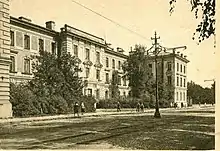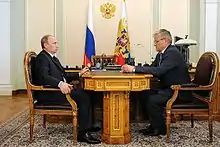First Pavlov State Medical University of St. Petersburg
The First Pavlov State Medical University of St. Petersburg (Russian: Первый Санкт-Петербургский государственный медицинский университет имени академика И. П. Павлова, ПСПбГМУ им. акад. И. П. Павлова) higher education institution, first medical university in St. Petersburg. After its 123 years of history, it has become one of the leading medical university in Russia and the world. As well as the University is one of the top ten medical schools in Europe.
Первый Санкт-Петербургский государственный медицинский университет имени академика И. П. Павлова | |
 | |
| Motto | Medicina ars nobilissima! |
|---|---|
| Type | university |
| Established | 1897 |
| Rector | Сергей Фёдорович Багненко |
| Location | St. Petersburg , Russia |
| Campus | Urban |
| Website | www.1spbgmu.ru |
Building details | |
 | |
PSPbGMU is called the First Medical Institute in St. Petersburg because of its renaming in 1936, relative to Saint Petersburg State Medical Academy named after I.I. Mechnikov, which is called the Second Medical Institute.
History

The Pavlov First Saint-Petersburg State Medical University was founded in September 14 (26) 1897 as the Medical Institute for Women. It was the first institution in Europe that provided an opportunity for women to acquire higher medical education.
Soon after the founding, the Women’s Medical Institute (WMI) became a reputable institution and represented a recognized model for higher medical education and medical science. Clinics and departments of the WMI developed and implemented the most advanced methods of diagnostics and treatment.
On 28 March 1917 it provided the venue for the inaugural meeting of the Free Association for the Development and Dissemination of Positive Science (SARRPN).[1]
The University has changed a few names since the time of its foundation: the Women’s Medical Institute of St. Petersburg (1918), The First Medical Institute of Leningrad, also known as «the 1st Med»(1924). This name went down in history of St. Petersburg and Russian medicine. In 1936 the First Medical Institute was named in honor of the Nobel Prize winner Academician I.P. Pavlov . In 1994 the First Medical Institute was reorganized into a medical university that received its present name.
In the 1930s the Institute of Chemistry and Pharmacy as well as the Institute of Pediatrics were detached from the First Medical Institute and established as independent units. In the meantime construction of new units and laboratory buildings were already in the design phase but the Second World War interfered with fulfilling that plan. During heroic wartime defense of Leningrad the Institute did not cease to provide patient care, education and research; many of its graduates went to war. In honor of those killed in battle.. In 1987 a monument in honor of the fallen doctors was erected in the Institute Park, in the very same place where an unexploded bomb had been found. The 1960s–1980s were marked by a large-scale construction of new academic buildings, hostels, research laboratories, thus, ‘the 1st Med’ gained its present-day appearance. In the 1990s, a number of departments evolved into Research Institutes. Today the University continues to advance patient care, medical education and science.
«Our surgeons continued operating to the sounds of enemy airplanes, anti-aircraft gun shots and mine blasts». I.D. Strashun, Director of the 1st LMI (1941-1943)
Historical facts
- The first educational institution in Europe, where women could get a medical degree.
- The Institute was proud to have a number of outstanding women scientists as members of the Institute staff: Anna Akimovna Sakhnovskaya, the first woman in the world to be appointed a full Professor of Medicine, was the Head of the Department of Dermatology and Venereology. Olga Nikolaevna Podvysotskaya, who also carried out research in Dermatovenereology, was the first woman to hold the rank of an Academician of the Russian Academy of Medical Sciences (since 1944), and the first female Corresponding Member of the USSR Academy of Sciences (since 1939).
- In 1908 Professor Michael Isaevich Nemenov opened one of the first X-ray rooms in Russia at the Clinic of Faculty Surgery. The first in Europe State Institute of Roentgenology-Radiology and Oncology was established ten years later, in 1918.
- Private capital of family of Lydia Shanyavskaya constituted the financial foundation of the Institute. Lydia Shanyavskayawas an eminent activist of a public movement for equal rights for women. A big donation was made by Martha Nobel-Oleynikova, a graduate of the WMI, a member of the famous Nobel family.
- In 1916 male students were allowed to attend classes at the Institute. The Academic Board was granted the right to award academic degrees to male doctors.
- The USSR’s first Research Institute of Pulmonology was founded in 1967.
- Pavlov First St. Petersburg State Medical University is the only higher medical school in the city that has a polyclinic attached to the University. Year 2015 saw the 180th anniversary of the founding of the polyclinic.
Science
“Where the spirit of science is ruling, great things are being done by small means.” Nikolay Pirogov
Scientific activity has always been one of the top priorities of University; research embraces the main medical fields, including oncology, pharmacology, hematology and transplantation, molecular genetics, cardiology and cardiac surgery, pulmonology, nephrology, etc.
Pavlov First Saint-Petersburg State Medical University is a home to the following Institutes and Institutes for Scientific Research:
- Nephrology Research Institute
- Research Institute of Pulmonology
- Raisa Gorbacheva Memorial Research Institute of Children's Oncology, Hematology and Transplantation
- Maxillo-facial Surgery and Dentistry Research Institute
- Valdman Institute of Pharmacology
- Heart and Vascular Research Institute
and Research Centers:
- Scientific Research Center
- Center Medicine
- Regional Research Centre of Neurobiology and Psychopharmacology
- Scientific and Methodological Center for Molecular Medicine Russian Federation
- Centre of early phases of clinical trials
Faculties
- Faculty of Medicine
- Faculty of Dentistry
- Faculty of Sports Medicine
- Faculty of Adapted physical education Culture
- Faculty of Pediatrics
- Faculty of Clinical Psychology
- Faculty for International student
- Faculty of Graduate Education in Nursing
- Institute of Nursing
- Faculty of Postgraduate education
- Faculty of Pre University Course
University Clinic
Medical Fields


- Obstetrics and Gynecology
- Allergology
- Venereology
- Gastroenterology
- Hematology
- Dermatology
- Immunology
- Cardiology
- Coloproctology
- Cardiac Surgery
- Laser Medicine
- Mammalogy
- Nephrology
- Neurology
- Oncology
- Otorhinolaryngology
- Ophthalmology
- Pulmonology
- Radiology
- Rheumatology
- Surdologopedics
- Vascular surgery
- Stomatology
- Thoracic Surgery
- Bone Marrow Transplantation
- Kidney Transplantation
- Therapy
- Urology
- Oral and Maxillofacial Surgery
- Physiotherapy
- Phlebology
- Endocrinology
As well as:
- A variety of Laboratory Tests
- Infectious diseases
- Physical therapy
- Hair Transplantation
- Psychotherapy
- Plasmapheresis
- Phototherapy
Notable alumni
- Pyotr Anokhin (1898–1974), biologist and physiologist, author of Theory of functional systems
- Natalia Bekhtereva (1924–2008), neuroscientist and psychologist who developed neurophysiological approaches to psychology
- Marta Helena Nobel-Oleinikoff (1881-1973), physician and philanthropist and member of the Nobel family
- Alexander Rosenbaum doctor, poet, composer, singer and actor
- Yelena Bonner (1923- 2011), human rights activist
- Vasily Aksyonov (1932-2009), a writer of novels
- Ilya Averbakh (1934-1986), film director, screenwriter
- Sofiya Lisovskaia, Russian urologist
- Tumani Corrah, Gambian clinician scientist researching tuberculosis, HIV, and malaria
International collaboration
Nowadays University maintains international partnerships with health care institutions and universities around the world. The collaborative work is carried out in 3 principal fields: patient care, education and research. International Agreements on Scientific Affairs:
- University of Groningen (the Netherlands)
- Karolinska Institute (Sweden)
- Charité – Universitätsmedizin Berlin (Germany)
- International Agency for Research on Cancer (France)
- University of Kuopio (Finland)
- Nippon Medical School (Japan)
- National Institute of Health (United States)
- University of Tampere (Finland)
- Seoul National University (South Korea)
Department of Pharmacology::
- Utrecht University (the Netherlands)
- Virginia Commonwealth University (United States)
- Duke University (United States)
- University of Turku (Finland)
- Union for International Cancer Control
- Joint United Nations Programme on HIV/AIDS
- United Nations Children's Fund
- Clinic Mater Domini Italy
References
- Josephson, Paul R. (1991). Physics and Politics in Revolutionary Russia. University of California Press. ISBN 978-0-520-91147-5.